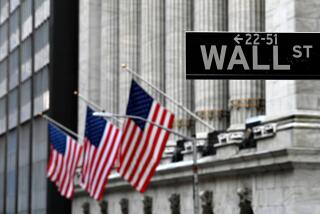Betting Big on Foreign Stock Funds
- Share via
The rush by U.S. investors into foreign stocks reached a new level in January, with a record $23.6 billion in fresh cash pouring into international mutual funds, a trade group said Monday.
The inflow -- nearly three times the amount investors pumped into U.S. stock funds -- underscored one of the biggest changes in Americans’ attitudes about investing over the last year: Many people are far more interested in sending money abroad than keeping it home.
Some financial advisors say the unprecedented popularity of foreign shares with small investors is long overdue as Americans diversify their holdings after more than a decade in which they paid little attention to overseas markets. The appeal of foreign markets has risen as their returns have trounced U.S. stocks’ gains since 2002.
“Obviously this is in large part a matter of people chasing performance,” said Paul Merriman, head of Merriman Capital Management Inc. in Seattle.
That is worrisome to some on Wall Street who recall the rush by small investors into technology stocks late in 1999 and early in 2000, at the zenith of the dot-com mania. As the shares collapsed later in 2000 and in 2001, the consequences were ruinous for some investors who were the last to buy in.
“It’s inevitable that the bulk of the money comes in after most of the performance advantage is over,” said Neil Bathon, president of Boston-based Financial Research Corp., which tracks mutual fund purchases.
The record January cash inflow to foreign stock funds, reported Monday by the Investment Company Institute, was almost twice December’s level.
Investors also turned more positive on U.S. stock funds last month, although their enthusiasm was nowhere near what it was for foreign funds. Domestic equity funds had a net inflow of $8.2 billion in January, compared with a net outflow of $2.5 billion in December, the institute said.
Net cash inflows or outflows are new purchases minus sales by investors pulling money out.
For all of 2005, Americans bought a net $104.6 billion of foreign mutual fund shares, compared with $31.2 billion in net purchases of domestic fund shares, institute data show.
Foreign funds’ investment returns have rewarded people who have taken the plunge over the last three years, and overseas markets mostly are beating the U.S. market this year as well.
The average foreign stock fund has risen 29.2% a year over the last three years, compared with 20% for the average U.S. fund, according to Morningstar Inc. The best returns were tallied by funds that own Latin American stocks. Those funds rose 64.2% a year, on average, over the last three years. Europe-focused stock funds climbed 32% a year.
Through Friday, the average foreign fund was up 7% year to date, compared with a 4.6% gain for U.S. funds.
The continuing rallies in foreign markets have caused some Wall Street firms to warn against jumping in. Brokerage Morgan Stanley recently directed clients to pare their holdings of Japanese and emerging-market shares and buy U.S. stocks instead. The firm said domestic stocks were better bargains than many foreign issues.
Still, many financial advisors say comparisons between the tech-stock boom of the late 1990s and the current investor hunger for foreign stocks aren’t valid.
For one thing, technology is a narrow industry sector; foreign stocks, by contrast, are a bet on the entire global economy outside the U.S. As most investors know, growth in countries such as China and India has been a driving force for the world economy in this decade, benefiting the rest of Asia as well as Latin America, Europe and the U.S.
Mark Headley, president of Matthews International Capital Management Inc. in San Francisco, which manages a number of stock funds that focus on Asian securities, said he believed that Americans had woken up to the long-term prospects for economic growth in the rest of the world, after largely ignoring foreign markets in the 1990s.
“I think this is more a natural reallocation [of assets] than some mad rush,” Headley said.
Merriman said he continued to recommend that clients keep 50% of their stock portfolios in foreign funds and 50% in the U.S. Besides the potential for cashing in on economic growth overseas, foreign securities offer a way for investors to diversify away from the dollar, in case the U.S. currency suffers a further devaluation over time, he said.
But the danger, Merriman said, was that investors were being lulled into believing that foreign stock markets only go up. What’s more, he noted, the dollar’s weakness since 2002 has helped boost overseas fund returns by making foreign shares worth more. If the dollar strengthened, it could cut into foreign returns.
Geordie Crossan, president of advisory firm NBS Financial Services Inc. in Westlake Village, said he was warning clients that “if this is your first time [buying] foreign stocks, it’s probably not a good move” unless their time horizon was truly long term.
*
(BEGIN TEXT OF INFOBOX)
Chasing performance?
Foreign stock mutual funds are attracting growing numbers of U.S. investors thanks in part to steep gains over the last three years compared with U.S. stock funds.
Three-year average annualized returns* of selected fund categories
Latin America: +64.2%
Emerging markets: +41.8%
Foreign small growth stocks: +38.1
Foreign small value stocks: +34.8%
Europe: +32.0
Average foreign fund: +29.2%
Foreign large value stocks: +29.0%
Japan: +27.3%
Foreign large growth stocks: +26.4%
Average U.S. fund: +20.0%
*Data through Friday
Source Morningstar Inc.
More to Read
Inside the business of entertainment
The Wide Shot brings you news, analysis and insights on everything from streaming wars to production — and what it all means for the future.
You may occasionally receive promotional content from the Los Angeles Times.










